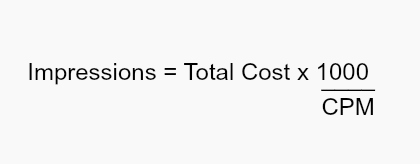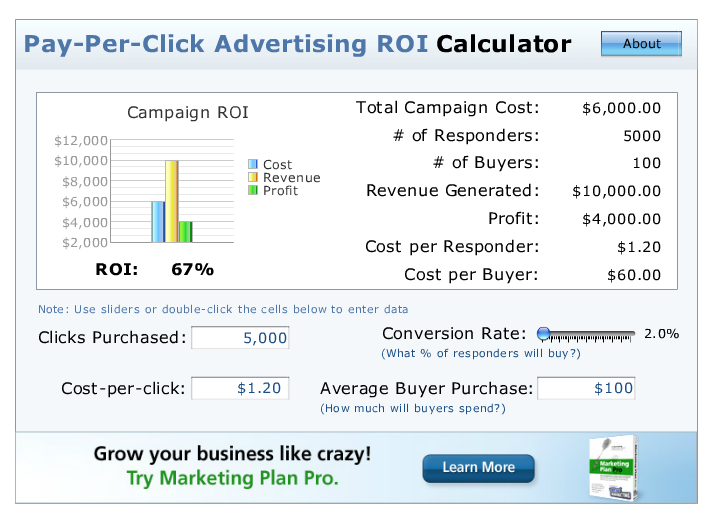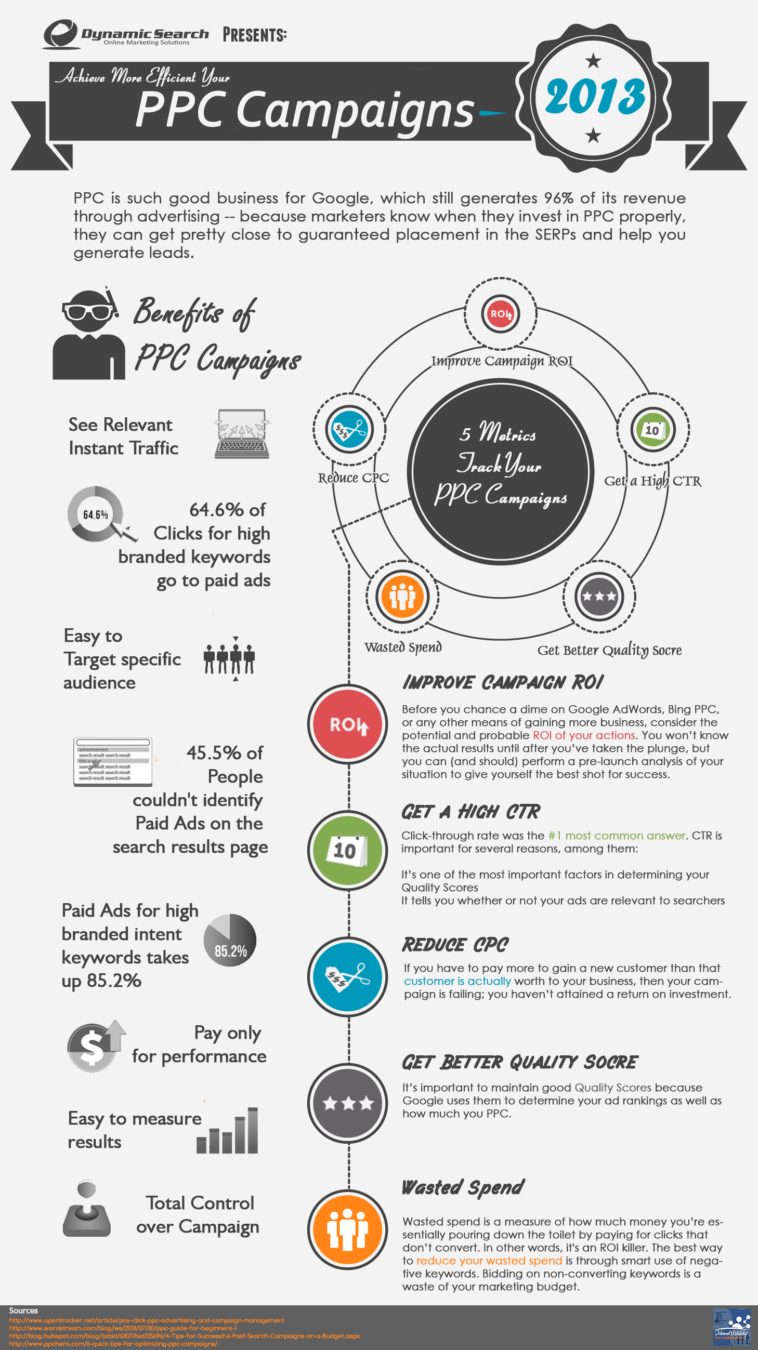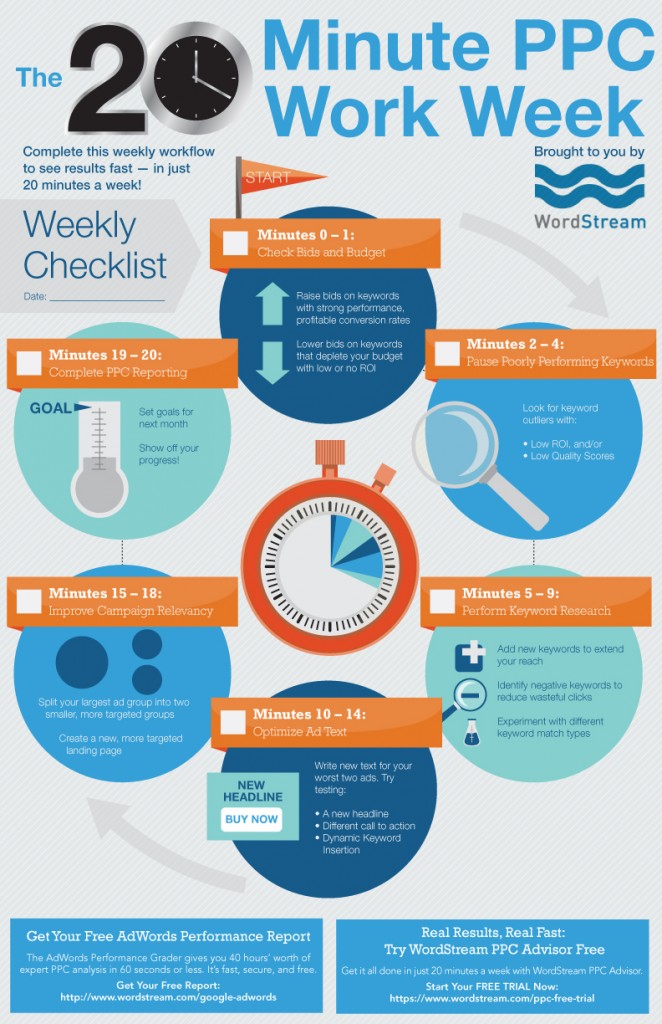SaaS PPC Advertising ROI Calculator and Metrics You Should Concentrate On
Last updated: January 23rd, 2014
Calculating return on investment is one of the most important parts of conducting SaaS pay per click marketing campaigns. Yet, many advertisers don’t give it much thought. If you aren’t calculating your ROI for your PPC campaigns, you’re simply burning your money. Many businesses select a keyword, set up their campaign and sit back and relax, expecting customers and leads to roll in. Doing that without analyzing is worse than not doing anything at all. If you aren’t analyzing your PPC campaign results, you’re simply wasting your time, money and resources.
In this post I will be discussing which pay per click metrics to track and how to calculate them manually. I will also be sharing a PPC ROI calculator for those who want their ROI calculated automatically after inputting data, as well as four essential PPC tracking programs.
How ROI Changes:
- If the average sale increases, so does ROI. If the average sale decreases, ROI decreases. Ideal situation: The average sale should increase.
- When the cost per click increases, the spend on advertising does too, so the ROI decreases. Ideal situation: Cost per click should decrease.
- When the conversion rate increases, you need to spend less on advertising to get a sale so that the ROI, in turn, goes up. Ideal situation: Conversion rates should increase.
Determining the ROI of your campaign all comes down to four elements: advertisement cost, clicks, conversions and revenue.
Pay Per Click (PPC) metrics to track:
While conducting PPC campaigns you might end up with a large amount of data and get confused as to which metrics you should focus on. For successful tracking you can concentrate on the following:
1) Clicks:
Clicks and impressions are two important metrics that should be focused on. Impressions measure the number of times an advertisement is displayed and clicks refer to the number of times it is clicked on. A higher number of clicks indicates that the ad was well made and attractive enough to generate a decent click through rate. It also indicates how well the total impressions converted into click throughs. If the clicks increase, it might be a good time to capitalize on the increase in traffic and increase ad budget. If clicks go down it could mean that something is wrong with the ad and it might need formatting.

2) Cost Per Click (CPC):
The average amount you pay per ad click is called cost per click. CPCs vary from industry to industry and are higher for some keywords, based on competitiveness.You can bring down your CPC by going for long tail keywords but you may not want to do that if you want to stay competitive for your main keyword.
3) Click Through Rate (CTR):
Click through rate is defined as the number of times an ad is clicked on, divided by the number of times the ad was shown.
4) Quality Score:
Quality score is a number that Google gives based on the past CTR rate of your keyword, quality of your landing page and relevancy of your keywords. A high quality score means that your keyword and landing page are relevant to the person looking at your ad. Quality score is what Google uses to determine the ad rank and make sure that the highest positions go to the most relevant ads.
5) Impression Share:
Impression share measures the number of impressions an ad receives vs. the number of impressions it was eligible to receive. So if the total number of searches performed for your keyword was 1,000 but your ad only showed 800 times, it means you had an 80% impression share and 20% lost impression share. After looking at the lost impression share you should be able to decide whether to increase the budget or to raise bids. Lost impression share allows you to find out how many impressions were lost due to budget constraints or low ad ranks. You can also calculate the clicks and conversions you could have received if you had received those lost impressions.
6) Number of Conversions (Conversion Rate):
Conversion rate is the percent of people who buy. Conversion rate measures how often clicks are made on your ad and resulted in a conversion such as a sale, lead , sign up etc. Some people conduct PPC campaigns to simply increase brand awareness, but most aim to achieve a high number of conversions.
Another important metric here is Cost Per Impression (CPI) which is the percentage of people who convert after clicking an ad to the total number of times the ad is shown.
7) Cost Per Conversion:
Cost per conversion is the amount spent to acquire a sale or a lead. If you spent $100 on your campaign and made 2 sales, it would mean that the CPC for each was $50. There is no specific CPC you should aim for, as it all depends on how much value a sale has for you.
8) Total Conversion Value:
Total conversion value is an important metric to look at in relation to keywords and ad campaigns. The total conversion value for some products is higher than others.
9) Return on Ad Spend (ROAS):
Return on ad spend or ROAS is used to determine the value and outcome of an advertising campaign. ROAS calculates how much revenue was earned for every dollar spent. The higher the ROAS, the higher the return but you should aim to achieve the break-even point as a minimum so as not to lose money. The break-even point for ROAS is $1:1, which means that for every $1 spent on advertising you are earning $1 as revenue.
Before we look into the various ways to calculate return on investment, let’s have a look at some pay per click marketing infographics:
So what are the different ways to calculate return on investment?
ROI can be calculated manually in the following ways:
1) ROAS:
Return on ad spend is simply PPC revenue minus PPC cost divided by PPC cost and is shown as a percentage. It can be explained as the revenue generated from your PPC campaign minus the cost involved.
2) ROI:
ROI sounds just like ROAS but the difference lies in the way they are calculated. ROI takes into consideration all the costs and not just click costs. To get the true ROI you have to consider every single cost incurred in producing the product/service such as shipping and handling fees, employee salaries, etc.
3) Profit Per Impression and Profit Per Click:
Profit per impression and profit per click are about generating optimal profit based on the lowest possible cost and depend on factors such as selecting the right keyword, optimizing ads and converting people from searchers to buyers.
You can choose to use any of the above methods based on preference and purpose but once you choose one decide to stick with it for better results. Let’s calculate ROI manually with an example:
For example, you spend $1 per click and each convert is worth $50. You convert at 3% and generate 1,000 clicks. In this case, your ROI would be:
ROI= ((Total Revenue – Total Cost) / Total Cost ) x 100
Total Revenue= Value of a conversion x Conversion rate x Number of clicks
= 50 x 3% x 1,000
= 1,500
Total Cost = Spend per click x Number of clicks
= 1 x 1,000
= 1,000
ROI = (( 1,500 – 1,000) / 1,000 ) x 100
= 50% (equivalent to $500)
But what if you’re not selling a product or service? What if blogging is your business? You can still calculate ROI.
You will begin by calculating the cost of one blog post:
Blog post cost: Number of hours x Hourly rate
Let’s say it takes you 2 hours to complete one blog post and you set your hourly wage rate at $30.
Blog post cost= 2 x 30
= 60
Let’s assume a conversion value of $30 and a conversion rate of 0.2% (sine organic traffic is not as well honed as PPC traffic). Also work out the number of page views the post will receive in its lifetime based on your blog traffic. Let’s say you get 1,500 page views for this example.
ROI = ((Total Revenue – Total Cost) / Total Cost ) x 100
Total Revenue= Value of a conversion x Conversion rate x Number of page views
= 30 x 0.2% x 1,500
= 90
ROI =((90-60) / 60 ) x 100
= 50% (equivalent to $30)
Instead of computing ROI manually you can take the help of ROI calculators. Here’s a calculator that will help you out in determining your ROI and assess performance:

You can access the PPC ROI Calculator here: PPC ROI Calculator
You can also learn how we use PPC ROI forecasting in our methodology for scaling SaaS businesses.
What you should do now
Whenever you’re ready…here are 4 ways we can help you grow your B2B software or technology business:
- Claim your Free Marketing Plan. If you’d like to work with us to turn your website into your best demo and trial acquisition platform, claim your FREE Marketing Plan. One of our growth experts will understand your current demand generation situation, and then suggest practical digital marketing strategies to hit your pipeline targets with certainty and predictability.
- If you’d like to learn the exact demand strategies we use for free, go to our blog or visit our resources section, where you can download guides, calculators, and templates we use for our most successful clients.
- If you’d like to work with other experts on our team or learn why we have off the charts team member satisfaction score, then see our Careers page.
- If you know another marketer who’d enjoy reading this page, share it with them via email, Linkedin, Twitter, or Facebook.













